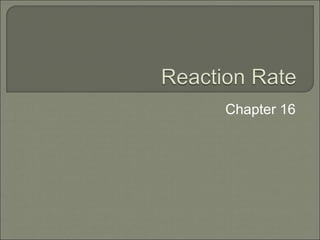
chapter_16.ppt
- 1. Chapter 16
- 2. The time taken for the disappearance of the reactant or the appearance of the product . Rate is a ratio as the amount of reactant disappeared divided by the time. Average rate: The change in the concentration divided by the total time elapsed. Rate = amount reacted or produced/ time interval units: g/s, mol/s, or %/s
- 3. Instantaneous rate: rate measured between very short interval Initial rate: instantaneous rate at the beginning of an experiment
- 5. Rate depends on the concentration: In some reactions doubling the concentration doubles the rate of reaction. In some doubling the reaction increases the reaction four folds.This happens in the decomposition of HI to form H 2 and I2.
- 6. An expression for the rate of a reaction as a function of the concentration of one or more of the reactants. Rate=k [A]n This equation is the general rate law. The exponent n , is called the order with respect to substance A and must be determined from experimental data.
- 7. Order of a chemical reaction can be said as the exponent on the concentration for a specified reactant in a rate law expression.
- 8. Determine the rate law equation for the following reaction , given the experimental data 3AC Concentration of A Reaction rate 0.2M 1.0M/s 0.4M 4.0M/s
- 10. The rate law equations you have looked so far have been for reactions involving only one reactant. If more than one reactant is found to contribute to the rate of the reaction, then all contributing reactants must appear in the rate law. The rate law equation for this will be rate=k [A] n [B] m
- 11. The value of n is the order with respect to reactant A. The value of m is the order with respect to reactant B. The overall reaction order will be the sum of n and m. From the above equation if you double the concentration of A and the rate doubles then the reaction is first order with respect to A. If you double the conc. of B (keeping the conc of A constant, and the rate quadruples the the rate of the reaction is second order with respect to B.
- 12. For the reaction A and B for this example the rate law would be rate=k[A][B]2 Rate laws cannot be derived from a chemical equation. 2N2O₅↔4NO2+O2 Keq=[NO2] 4 [O2]/[N2O₅]2 rate=k[N2O₅]1
- 13. The slowest step in a mechanism, the step that determines the overall rate of reaction is the rate determining step. Mechanism is a proposed sequence of steps that describes how reactants are changed into products. Each step in the mechanism is called as elementary step.
- 14. Page 598 Critical thinking 2,3,5 Practice problems 7and 8 all
- 15. Temperature: An increase in temperature is accompanied by an increase in the reaction rate. Temperature is a measure of the kinetic energy of a system, so higher temperature means higher average kinetic energy of molecules and more collisions per unit time. For most chemical reactions the rate at which the reaction proceeds will approximately double for each 10°C increase in temperature. Once the temperature reaches a certain point, some of the chemical species may be altered (e.g., denaturing of proteins) and the chemical reaction will slow or stop.
- 16. Concentration: A higher concentration of reactants leads to more effective collisions per unit time, which leads to an increasing reaction rate (except for zero order reactions). Similarly, a higher concentration of products tends to be associated with a lower reaction rate.
- 17. Medium: The rate of a chemical reaction depends on the medium in which the reaction occurs. It sometimes could make a difference whether a medium is aqueous or organic; polar or nonpolar; or liquid, solid, or gaseous.
- 18. Surface area: It is easier to dissolve sugar if it is crushed. Crushing the sugar increases its surface tension.The larger surface area allows more sugar molecules to contact the solution.
- 19. Catalyst: A catalyst is a substance that alters the rate of a chemical reaction without being used up or permanently changed chemically. A catalyst works by changing the energy pathway for a chemical reaction. It provides an alternative route (mechanism) that lowers the Activation Energy meaning more particles now have the required energy needed to undergo a successful collision.
- 20. What is activation energy? The least amount of energy needed to permit a particular chemical reaction.
- 21. There are 2 types of catalysts: Homogeneous catalyst: Homogeneous catalysts are in the same phase as the reactants. Heterogeneous catalyst: Heterogeneous catalysts are present in different phases from the reactants (for example, a solid catalyst in a liquid reaction mixture), whereas homogeneous catalysts are in the same phase (for example, a dissolved catalyst in a liquid reaction mixture).
- 22. Example of Homogeneous catalyst 2H2O2(aq)+ KI(aq)2H2O(l)+O2(g) Example of Heterogeneous catalyst Decomposition of H2O2 in presence of MnO2 Hydrogen peroxide is a solution while manganese dioxide is a solid and can be easily separated.
- 23. Term review all Page 614 13,22, 23 and 25 Test prep all